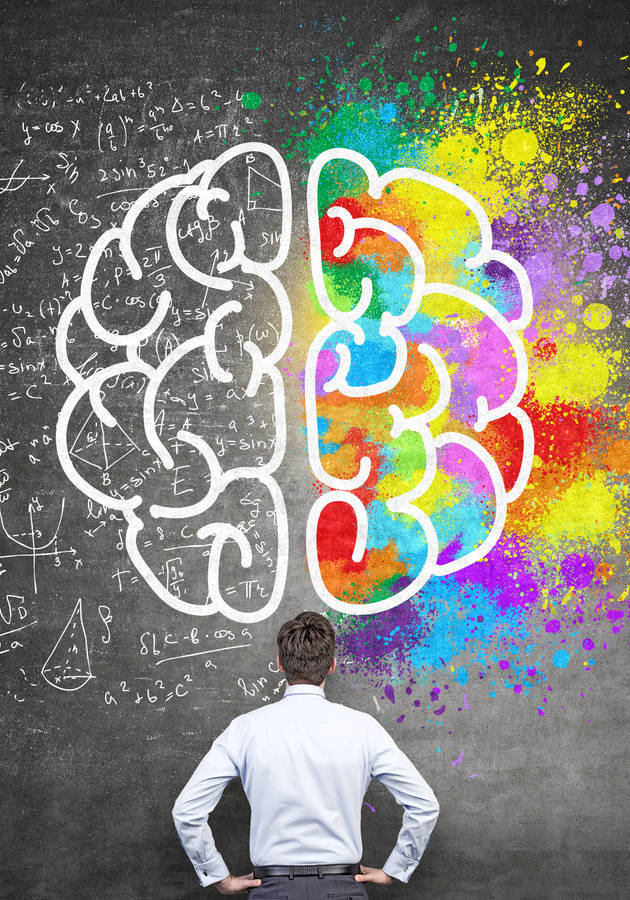As everybody knows, our brains are divided into two hemispheres. The left is sequential, logical, and analytical, while the right is nonlinear, intuitive, and holistic. In “A Whole New Mind,” bestselling author Daniel H. Pink uses these differences to yield “a powerful metaphor for interpreting our present and guiding our future,” suggesting that some of the supposedly frivolous qualities of our right brain – such as inventiveness, empathy, joyfulness, and meaning – will power the economy of the future, during the up-and-coming Conceptual Age.
So, get ready to learn how to survive and thrive in this emerging world of tomorrow and prepare to learn the six essential aptitudes on which professional success and personal satisfaction will depend in the future.
The two halves of your extraordinary brain
Your brain, Woody Allen’s second favorite organ, is a complex thing. In fact, according to James Watson – the man who discovered the structure of DNA – it may be “the most complex thing we have yet discovered in our universe.” Just consider the numbers: a typical brain consists of some 100 billion cells, “each of which connects and communicates with up to 10,000 of its colleagues.” Together, they forge an elaborate network of about one quadrillion connections that “guides how we talk, eat, breathe, and move.”
And yet, for all its complexity, the brain’s topography is “simple and symmetrical.” There is a sort of “neurological Mason-Dixon Line,” which divides the brain into two regions, your left and your right hemisphere. For most of history, scientists deemed these regions “separate but unequal.”
Thanks to the discovery that man’s ability to understand and speak language depends almost exclusively on the proper functioning of the left hemisphere, during the 19th century it was the left side of the brain that was considered essential, and the right illiterate, subordinate, and sometimes “not even conscious.” However, in the 1950s, “soft-spoken Caltech professor” Roger W. Sperry, after several experiments, conclusively proved that this supposedly minor and “mentally retarded” right hemisphere was, in fact, “the superior cerebral member when it came to performing certain kinds of mental tasks.”
Nowadays, we know for a fact that both halves of our brain are equally important and that both of them play roles in nearly everything we do. However, we also know that they don’t play the same roles and that they “take significantly different approaches to guiding our actions, understanding the world, and reacting to events.” It is the similarities between the two hemispheres that allow humans to be so complex and evolved beings; it is, however, the differences between the two that navigate their personal and professional lives.
The 4 differences between your left and your right hemisphere
Thanks to the advancements of technology and the fast dissemination of knowledge, during the last three or so decades, scientists managed to discover the four key differences between the left and the right hemisphere.
- The left hemisphere controls the right side of the body; the right hemisphere controls the left side of the body. Our brains are contralateral, meaning each half of the brain controls the opposite half of the body. In other words, it is the left-brain hemisphere that guides the movement of your right hand and vice versa. Since, in Western languages, we read and write from left to right, during the past two and a half millennia, these two habits have reinforced the dominance of the left hemisphere.
- The left hemisphere is sequential; the right hemisphere is simultaneous. The left hemisphere is good in recognizing serial events and controlling sequences of behavior. That’s why, even the Arabs who read from right to left, must use the left hemisphere as well, because that’s the half of your brain that is naturally involved in reading, writing and talking. The right hemisphere, on the other hand, is particularly adept at interpreting things simultaneously and very useful in interpreting faces. “Think of the sequential/simultaneous difference like this,” writes Pink. “The right hemisphere is the picture; the left hemisphere is the thousand words.”
- The left hemisphere specializes in text; the right hemisphere specializes in context. Even though it is the left side of your brain that is responsible for language-related activities, it wouldn’t be able to do the job on its own. The same sentence – say, “I love you!” – can mean different things in different contexts, and its meaning varies according to which word you’ll choose to emphasize. To oversimplify this a bit, the left hemisphere handles what is said, and the right hemisphere focuses on how it’s said: “the nonverbal, often emotional cues delivered through gaze, facial expression, and intonation.”
- The left hemisphere analyzes the details; the right hemisphere synthesizes the big picture. In general, the left side analyizes information – it breaks the whole into smaller components – while the right hemisphere synthesizes it – it weaves smaller components into a bigger whole. Put more colloquially, the left hemisphere is exceptional at grasping the details; but the details make no sense without the bigger picture that only the right hemisphere can see.
All in all, you need both hemispheres of your brain to lead a healthy, happy, and successful life. However, “the contrast in how our cerebral hemispheres operate does yield a powerful metaphor for how individuals and organizations navigate their lives.” Think of the people more comfortable with logical, sequential, and computer-like reasoning as left-directed thinkers; they tend to become programmers, engineers, lawyers, accountants. Right-directed thinkers, on the other hand, are holistic, intuitive, and nonlinear; they tend to become artists, entertainers, counselors, inventors. Strictly speaking in terms of imagery, it has always made a difference whether you’re essentially a left-directed or a right-directed thinker; it will make an even bigger difference in the most immediate future.
The 3 acts of modern history and the 3 A’s that will change it
Modern history is, essentially, a three-act drama.
- In Act 1, the Industrial Age, the protagonist was the mass production worker, defined by its personal fortitude and physical strength. Since the economy during these times was powered by efficient assembly lines and massive factories, brawn mattered far more than brains.
- But then came Act 2, the Information Age, and this all suddenly changed. Nothing was now more important than information, innovation, and knowledge. The central figure of this act was the knowledge worker, defined by the great Peter Drucker as someone with the “ability to acquire and to apply theoretical and analytic knowledge.” So, essentially, the knowledge worker was the archetypal left-directed thinker: the programmer, the physician, the statistician, the mathematician.
- However, at least in the West, we are currently living in the middle of the curtain-rising on Act 3, the Conceptual Age. Pink predicts it will be the age of two masters of right-directed thinking, the creator and the empathizer.
How did we arrive there? In essence, thanks to mass production workers and left-directed thinkers: they were just too good in what they were doing and made themselves obsolete in the end. This process, too, was a 3-act drama, moved by three forces that, with every passing day, are tilting the scales more and more in favor of right-directed thinkers:
- Abundance. With the material needs of millions satisfied – and even over satisfied – people have more time and energy to care for things like beauty, emotion, and meaning.
- Asia. According to most studies, 1 in 4 U.S. jobs is at risk of offshoring. The reason is simple: Asians can perform routine, left-directed work at significantly lower costs than Westerners. Consequently, knowledge workers in the West have no choice but to start mastering abilities that can’t be shipped overseas.
- Automation. Computers can do almost everything better, faster, and cheaper than people. So, very shortly, robots will almost certainly supersede low-cost Asians in the same way Asians overtook the jobs of left-directed Western thinkers, who, in turn, displaced blue-collar assembly line workers after the Industrial Age.
So, prepare for a dramatic change. Though left-directed aptitudes – “the sorts of things measured by the SAT and deployed by CPAs” – are still necessary, they are no longer sufficient. Artistry, empathy, intuitiveness, holistic thinking – a few right-directed aptitudes so often disdained and dismissed – will be increasingly sought-after in the future. “It’s a dizzying – but ultimately inspiring – change,” writes Pink.
The 6 high-concept, high-touch senses of the future
The Information Age was the age of high tech; however, high tech is not enough during these abundant times when someone overseas or a computer can do your job cheaper or faster. So, it’s time we start supplementing our high-tech abilities with abilities that are high concept and high touch. As defined by Pink, high concept “involves the ability to create artistic and emotional beauty, to detect patterns and opportunities, to craft a satisfying narrative, and to combine seemingly unrelated ideas into a novel invention.” High touch, on the other hand, “involves the ability to empathize, to understand the subtleties of human interaction, to find joy in one’s self and to elicit it in others, and to stretch beyond the quotidian, in pursuit of purpose and meaning.”
There are six essential right-directed aptitudes – which Pink calls the six senses – that should help you upgrade your left-directed skillset to another level and, eventually, develop the “whole new mind” demanded by your future.
- Design – not just function. According to a London Business School research, “for every percent of sales invested in product design, a company’s sales and profits rise by an average of 3 to 4 percent.” In other words, it’s no longer sufficient to create anything that’s merely functional: it is of crucial, financial importance your product, service, experience or lifestyle to also be “beautiful, whimsical and emotionally engaging.” So, get to work: visit a design museum, buy a few design magazines, and start a design notebook. Develop the ability to recognize what is beautiful and what resonates emotionally with people.
- Story – not just arguments. Claims and arguments don’t mean as much as they did in the past because of saturation: there’s just too much information and data around for them to find their way into other people’s minds. Fortunately, stories are still able to achieve this. “The essence of persuasion, communication, and self-understanding,” writes Pink, “has become the ability also to fashion a compelling narrative.” And the best way to learn to write stories is by reading them. Craft inventive stories evolving from your favorite book’s opening sentence. And the next time you’re in a large public space, don’t just ask yourself, “Who are these people around me?” Make up stories to answer the question.
- Symphony – not just focus. The Information Age was the age of analysis: it thrived on specialization and focus; the future belongs to those who can see the big picture, those who know how to synthesize things. Knowledge is widely available online today, so it’s not necessary to know the particularities; what is essential is to be able to combine them into something bigger and more meaningful – a harmonious symphony. Two great ways to expand your capacity for a symphony is to learn how to draw and to keep a metaphor log – both will train you to see associations.
- Empathy – not just logic. As computers take over the more logical aspects of our existence and organization, the people able to forge relationships and to empathize with others will be the ones to thrive. It’s easy to replace programmers with robots – but physicians, lawyers, and social workers are irreplaceable. To develop your empathy, put yourself in the shoes of others and volunteer. Also, take an acting class if you want to.
- Play – not just seriousness. As they say, all work and no play makes Jack a dull boy. It took us some time, but we finally realized that the human being is, essentially, a playing creature – “homo ludens” in Latin. This is why we have already started learning through video games, and people have started making serious money playing them. In the Conceptual Age, this will only intensify. So, get in touch with your inner child: laugh out loud, play games, be joyful. And do this while you’re working.
- Meaning – not just accumulation. A person with existential problems – shortages of food, clothes, or shelter – doesn’t have time to pursue “more significant desires,” such as “purpose, transcendence, and spiritual fulfillment.” However, nowadays, most Westerners are rich enough to do just that: as the pursuit of money becomes secondary, the search for meaning becomes a driving force in many people’s lives. Consequently, yoga studies, green products, and purposeful work assignments aiming to improve the world have evolved from being perks and embellishments to essential elements of the Western business world even today. Prepare for an even more spiritual future.
Final Notes
Thought-provoking, audacious, and profound, “A Whole New Mind” was originally published in 2006.
The years in between have vindicated Daniel Pink: the world has, indeed, become more creative and spiritual, and right-directed empathizers are increasingly more valued than left-directed knowledge workers.
It’s your turn.
12min Tip
Go beyond logic and money: master your aesthetic sense and storytelling skills while keeping an eye on the big picture and the spiritual aspects of our existence.





























